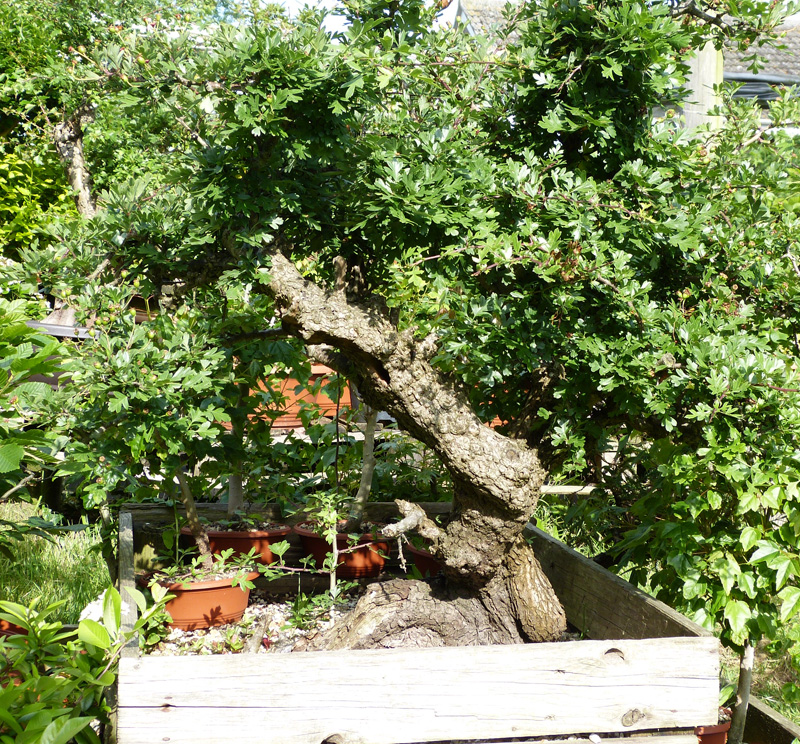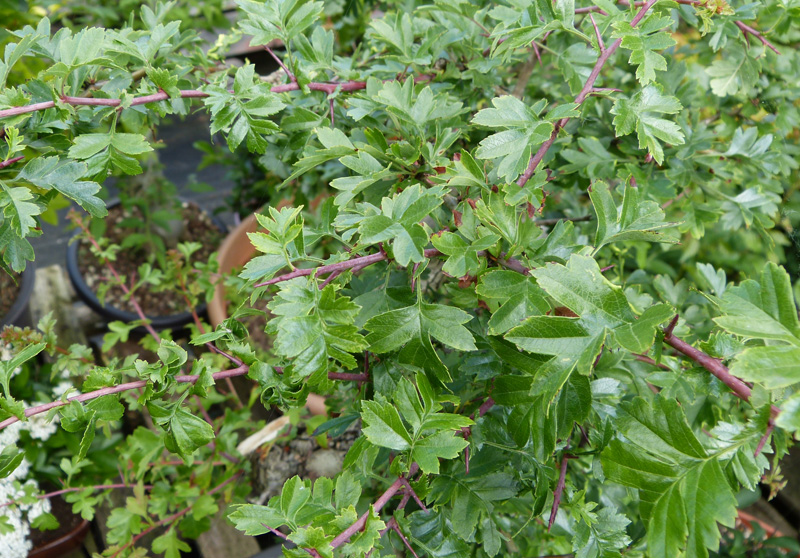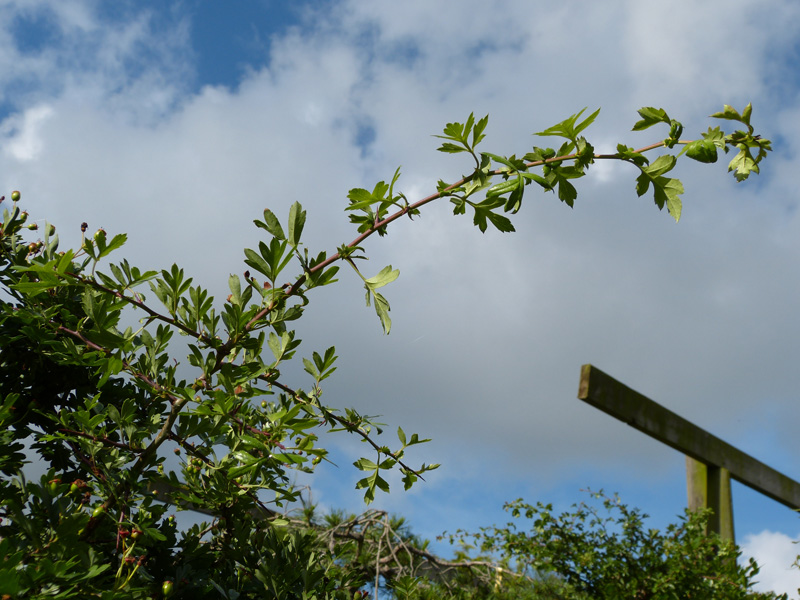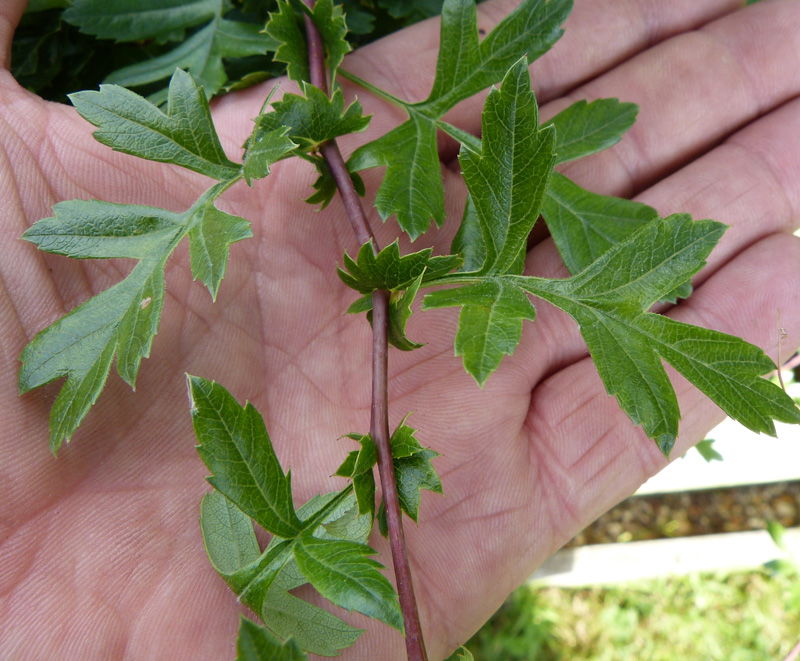This week (13 March) I did my first re-pot of 2018. This is an interesting one for a few reasons so I thought I would share it for all to see.
This is a very old yamadori hawthorn I bought off my mentor Kevin Willson several years ago when he was having a clear out. To be fair the tree was recently collected and there was a small element of risk involved on my part but the price was right and sometimes you just have to roll the dice. The tree was planted in a big wooden box, one of my pet hates in bonsai. I bought the tree back to the nursery and stood it on a bed of gravel in full sun.

Summer 2017. Big glossy leaves & massive growth everywhere. All is well.
The key to dealing with yamadori and particularly hawthorns is to be able to read the tree so you know when it’s possible to take the next step. Too early and the tree will either die or be set back, possibly years. Too late and you are getting old and valuable opportunities will have been missed. So, this tree did nothing much the following summer, it leafed out Ok but these were looking very sorry for themselves by mid summer, no second break and no extension growth. Combined, that’s a sure sign an old tree is struggling with a lack of vigour and too few roots. No fertilising that year and very little watering as the soil was not drying out significantly. All signs you have to wait!
Next year (I would assume 3rd year since collecting) the tree leafed out well in spring and by mid summer the leaves looked half decent and I got a couple of one inch extensions but still very little watering was required. Time to apply some more patience. In all this time the tree did not move a single inch and the box was quickly falling to bits so I just kept piling the soil back on top of it.
Now in the third year in my care and spring bugs were looking much better than in previous years, fatter and raring to go much earlier in the season. By mid summer I had too many four inch extensions to count, a second break and the leaves were twice the size of the previous year. The leaves also remained active and viable until leaf drop in autumn. It’s evident the tree had spent the entire previous season making roots rather than top growth and my patience was beginning to pay dividends.
With results like I had seen the previous year I would hazard a guess that ninety five percent of folk would be ordering a bonsai pot for the coming season and that’s why most ancient hawthorns never become bonsai. It’s true you can largely do what you like to the top of a ‘thorn but the roots need to be treated with ‘kid gloves’. The older a ‘thorn the slower it will be to recover and if you jump in too soon your world of hurt will extend far beyond the pain of a few thorn pricks. So here is what you need to see an old hawthorn yamadori doing before you go and get all mucky….
Spring 2017 duly arrived and my hawthorn was facing a very promising year ahead. It leafed out very early, the leaves were all an inch long (a quarter of that when we started) super shiny, deep green and held up high and proud like a Cruft’s champions tail. There was a decent show of flowers, the soil was drying out almost every day and by August I had two foot extensions (from the six months growth) as well as four to eight inch extensions everywhere. The tree was pushing new strong fat shoots out of everywhere including the big roots just under the soil. I even treated it to a couple of applications of Green Dream Fertiliser. The final indication all was VERY well was a complete lack of mildew or pest problems and beautiful strong autumn colour very late in the season. In my experience if your hawthorn is not growing like this it’s at best just surviving. I consider these signs and this level of growth to be an absolute minimum required before ANY work is done on a hawthorn, especially root work.

Big, thick shiny leaves and extension growth everywhere. Things were looking up.

About a foot and a half of extension in a couple of weeks!

Everything you need to know. Big leaves and getting bigger as the shoot extends, deep green, all perfectly formed and most importantly a deep shine. Thick even red shoot that does not taper.

Last summers growth from a bud. Those roots were doing their job.
Fast forward to March 2018 and i would RATHER leave the tree for another year just to be sure but the box has now completely fallen apart and I have to get this thing moving, I am after all running a business here. I have sat on this for five years now and looking ahead there’s a long way to go before I can recoup my investment. I am confident in the trees ability to withstand having it’s roots disturbed but always approach yamadori hawthorn with an air of trepidation and respect borne of many failures.
First issue i had was choosing my time. Large swelling buds and easily visible tiny white root ends everywhere indicated the time was right. EVERYONE re-pots bonsai too early and even at this stage I could have waited at least three weeks more but I have a lot to get done and so have to take liberties sometimes. Second issue was moving the thing which is part of my issue with boxes. The tree was rooted into the gravel bed for a start so I removed as much soil as i could and then with many hands and a shovel managed to get the tree with it’s rootball intact onto a cart. If the rootball of a hawthorn falls apart it will often strip away lots of fine feeder roots and those are the most important to keep. When collecting, even a massive tree will be kept alive by a small teacup of root which could easily be removed with a brush of the hand.

Still a bit early but I have lots of other trees to do. When the buds over the ENTIRE tree look like this it’s time to jump in.

With some roots exposed white tips indicate we chose the right time.

Into the workshop with the remnants of it’s box.

A lot of root and a lot of weight to deal with.
Once in the workshop I raked out as much as I could to get rid of the weight. Turning the tree on it’s side let gravity help me along a bit. Once free of the remnants of the box and with almost all the weight gone I was able to wrap and strap it and suspend at a convenient height for working. With delicate rooted large trees this avoids wrecking valuable growth rolling it around on a bench. With a little slim stick I was able to fluff up the roots and shake out all the remaining soil. I NEVER wash the soil off the roots of yamadori, it carries away too much of what the tree needs, don’t be lazy and leave the hose until after. Once clean I could see just how much root the tree had developed and from what I saw i would guess about ninety percent of this had happened since it was collected judging by the small area of field soil, collecting hawthorns, particularly in rocks is tough.

Up-ended, gravity helped me strip most of the weight of soil away

With the weight gone and the remaining rootball secure and tight I could suspend the tree in order to work without causing excess damage.
Looking at the exposed root system it was evident this tree was never going to fit into a bonsai pot or even the oversize training pot I was hoping to use. Time to get pruning and this is where it often goes wrong for folk potting yamadori for the first time. These trees are normally old and respect needs to be paid to that fact. In an ideal world what we want is to gather up ALL of the root and put it into it’s new container with new soil so the growth cycle it’s taken so long to build up can continue. Forget about big flat nebari and everything you learned about re-potting bonsai, this is NOT bonsai, survival and future development is the order of the day. “Bonsai” root pruning is something that comes much later and where hawthorns are concerned MUCH later.
Now that the entire root system is laid bare I could easily judge what I had to work with and the only real problem was a long thick root sticking out the back about a foot long and with a massive amount of root on it’s end. There was no way this was ever going to go into a pot of any reasonable size. By isolating the roots this carried from the rest I was able to judge just how much of the precious root system I would loose if I cut it away. Based on experience I was not entirely happy but considering the current strength of the tree I felt there was only a small degree of risk and so away it went. I did manage to find a couple of small side roots below which I cut, this should mean the remainder of this root stays alive and ensures I don’t lose an important strip of bark or live vein further up the tree. NO other roots were pruned in any way.

This was never going to go in a pot but on balance it was possible to remove most of it.
With my big prune out of the way it was evident this would now go into a nice small pot but, over the years, most of the big problems I have had with bonsai have been down to small pots and so i rummaged around to fine a pot that was too big. I will say what follows with my last breath…. ONLY EVER PUT BONSAI IN BONSAI POTS – Putting any plant into a bonsai pot WILL NOT, EVER, make it a bonsai. Putting ancient yamadori like this into a bonsai pot, at this stage, pretty much guarantees it will NEVER, EVER, EVER…… become a bonsai tree. I estimate another fifteen years before this needs a bonsai pot but today it’s very important to begin the process of developing the root system (structure and size) it will need when we get there. I turned up this huge mica bath tub that had been cluttering up the greenhouse for years, it’s significant depth and large size was just perfect and a great improvement to mobility over that old box.

Old mica bath tub proved to be just right.
One of the most important factors in potting a tree like this for the first time is to secure the tree properly. It takes a hawthorn years to make a lot of root and so wiring the tree into the pot to ensure it is steady is absolutely vital. Most folk never really master this particular art. It’s important to have good thick wire which needs to be pulling the tree downwards at an acute angle and this needs to be pulling down on something strong like a thick root. This really needs to happen in three places around the tree for maximum stability. Conveniently mica pots can easily be drilled with holes so this was an easy task in this case. Hopefully the picture shows what’s required. DO NOT SKIP THIS STAGE.

Three of these properly constructed and your tree will stay put.
Finally it was time to put some soil in the pot. As far as hawthorn go an alkaline mix is needed and this should be constructed from ingredients that will not break down over the long term seeing as hawthorn, particularly in large pots, don’t need to be re-potted above every ten years. Don’t use akadama in the UK, the frost will kill it in a few years and when you come to re-pot it will take most of your root with it. Our No 2 Bonsai Soil Mix has proven very successful with hawthorn over the years and in this case the addition of about 10-15% Pumice means this root system will be good for at least the ten to fifteen years this tree will take before it needs that bonsai pot.
Have a look at how Kaizen Bonsai soil mixes help root development for hawthorn.
Just one important pointer in relation to getting the soil into the pot. Add the soil slowly and use a slim stick to agitate the roots side to side in order to allow soil to get between them. We want a nice mix of soil and roots not a flat matt of roots squashed together with soil laying on top. Almost everyone I see re-potting bonsai uses a stick and stabs at the roots like a pshyco’ knife attacker. Move the stick side to side, not up and down. A lot more soil will go into the pot and the roots will remain in tact. Next use the stick, slid down the side of the pot to pull the roots inward slightly in order to leave a thin layer of soil between the pot and the roots. Roots hard up against the side of the pot will just trap water and encourage rot in the days prior to regrowth. Lastly a light watering, and I stress LIGHT and the job is done. No need to flood the pot, that’s old bollocks carried over from the practice of puddling in that gardeners do.
The last job I did to this hawthorn was a light prune to get rid of a lot of what I definitely didn’t need for the coming season. No point in growing lots of material where I won’t be needing it. It’s important not to overdo this, every bud produces solar panels that the tree really needs at this point. Don’t be tempted to get into a styling session!

All finished and pruned ready for the season ahead. This will probably end up being the front.

Finally I would like to talk about what you do with a tree after re-potting. Where the tree is placed is important and largely mis-understood. This tree was out in an exposed spot in full sun. After the re-potting work it might seem a good idea to put the tree in the greenhouse but this will just bring the top on too fast, before the roots have had time to regenerate, it also creates a potential problem when the tree is finally returned to the great outdoors as the leaves will have developed to suit an entirely different atmosphere. Most folk would place the tree in the shade which is absolute nonsense, particularly in the UK. The only way this hawthorn is going to recover and resume normal growth is by initially using the energy it has stored up in reserve thanks to it’s recent strong growth and ultimately from the energy it creates from sunlight. Putting it in the shade will reduce it’s light exposure to a massive extent and once the leaves do emerge it will be left struggling. By all means put the tree in a SHELTERED spot out of the wind but this ABSOLUTELY MUST be in full sun (such as it is in a typical British spring). I simply put this hawthorn right back in the same spot as before, that won’t mess with it’s internal clock, it’s got all the light it will need, a hawthorn is not effected by wind exposure and the temperatures are perfectly suited to where it is today because that’s what it had yesterday. There is no need to move a hawthorn about after re-potting, even if the temperature drops drastically so long as you didn’t water-log that soil. Hawthorn is tougher than a junk yard dog, at least a healthy one is. The joys of working on a strong healthy tree are entirely worth the long wait to get there in the first place.
Unless someone manages to prise this out of my hands I hope to bring you an update next year.
Graham.
March 2018

Interesting as usual Graham, the hawthorn is one of my favourite trees and combined with my knowledge your advice goes a long way.
Great blog spoken like a true Englishman
Regards Dave
Any real reason for keeping the small shoot at the base.
Best piece of solid advice on yamadori, and especially hawthorn repotting, I have read so far. Thank you for sharing your knowledge and taking a lot of your precious time to write it on your blog.
Thanks, Graham.
Lovely hawthorn,well worth the wait
I have one from an old hedge by the m6 which sat and sulked for five years before resuming normal growth,
Not many people sharing this sort of information,excellent stuff
Thanks for the great post Graham. Lots of good common sense information applicable in any climate regarding the relationship between the plant and its environment, and effects from radical changes to either. I wager there will be attempts to pry it out of your hands before you are willing to let it go. Hence, the need for tool$$$ to do the prying!
Great looking tree and a great article as always> Thank you Graham.
Great blog again Graham, inspirational as always.
Graham,
Truly inspirational stuff, and puts a beautiful context to yamadori Hawthorn, they really are a long term project.
Lovely.
Willie